Hyundai Terracan 2003 Owner's Manual
Manufacturer: HYUNDAI, Model Year: 2003, Model line: Terracan, Model: Hyundai Terracan 2003Pages: 349, PDF Size: 4.56 MB
Page 171 of 349
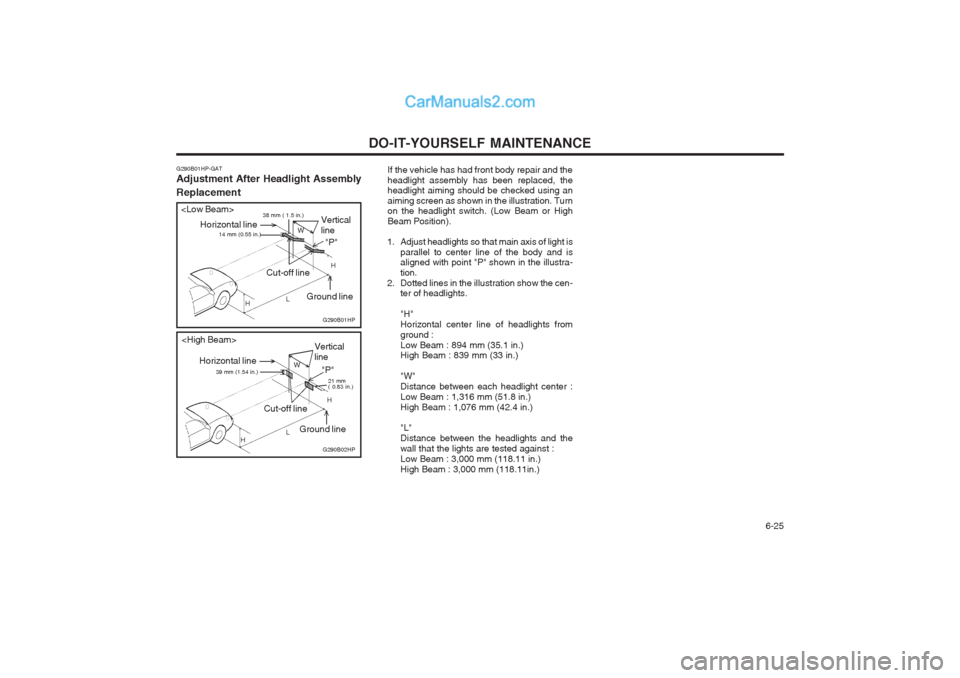
DO-IT-YOURSELF MAINTENANCE 6-25
If the vehicle has had front body repair and the headlight assembly has been replaced, the headlight aiming should be checked using an aiming screen as shown in the illustration. Turn on the headlight switch. (Low Beam or High Beam Position).
1. Adjust headlights so that main axis of light is parallel to center line of the body and is aligned with point "P" shown in the illustra- tion.
2. Dotted lines in the illustration show the cen- ter of headlights. "H" Horizontal center line of headlights fromground :Low Beam : 894 mm (35.1 in.) High Beam : 839 mm (33 in.) "W" Distance between each headlight center :Low Beam : 1,316 mm (51.8 in.)High Beam : 1,076 mm (42.4 in.) "L" Distance between the headlights and thewall that the lights are tested against :Low Beam : 3,000 mm (118.11 in.)High Beam : 3,000 mm (118.11in.)
G290B02HP
Vertical line
Cut-off line Ground line
L W
H
H "P"
21 mm ( 0.83 in.)
Horizontal line 39 mm (1.54 in.)
Vertical line
Cut-off line Ground line
L W
H
H "P"
38 mm ( 1.5 in.)
14 mm (0.55 in.)Horizontal line
G290B01HP-GAT Adjustment After Headlight Assembly Replacement
G290B01HP
Page 172 of 349
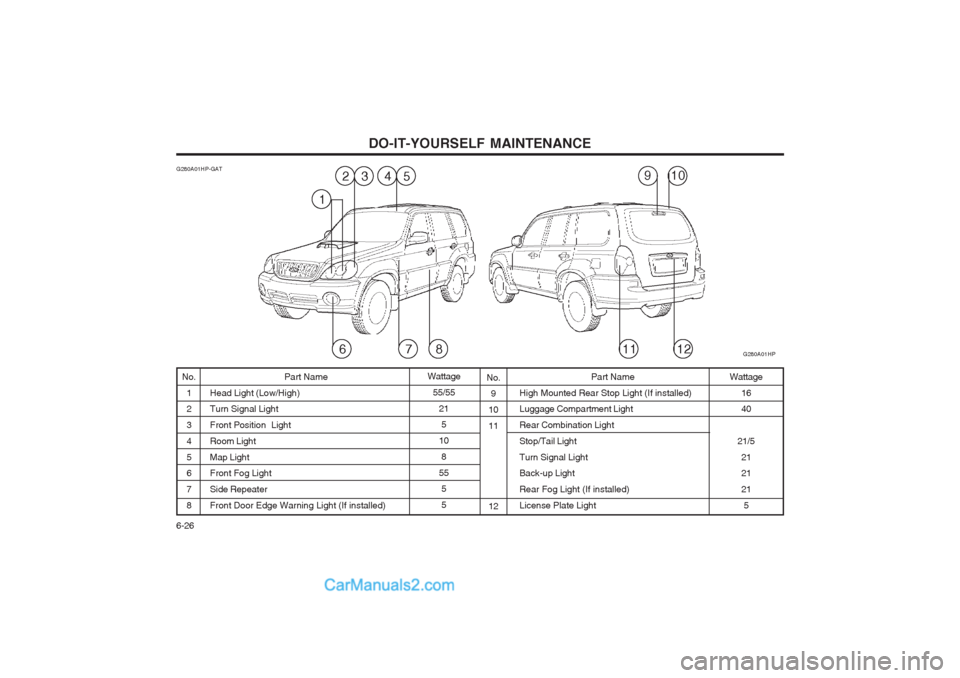
DO-IT-YOURSELF MAINTENANCE
6-26 No.
9
10 11 12 Wattage
16 40
21/5 2121 215
G280A01HP-GAT
No.
1 2 345 6 78 Part Name
Head Light (Low/High) Turn Signal Light
Front Position LightRoom LightMap Light Front Fog Light Side RepeaterFront Door Edge Warning Light (If installed) Part Name
High Mounted Rear Stop Light (If installed) Luggage Compartment Light Rear Combination LightStop/Tail LightTurn Signal Light Back-up Light Rear Fog Light (If installed)License Plate LightWattage 55/55 215
10
8
55 5 5
G280A01HP
532
87611
910
1
4
12
Page 173 of 349
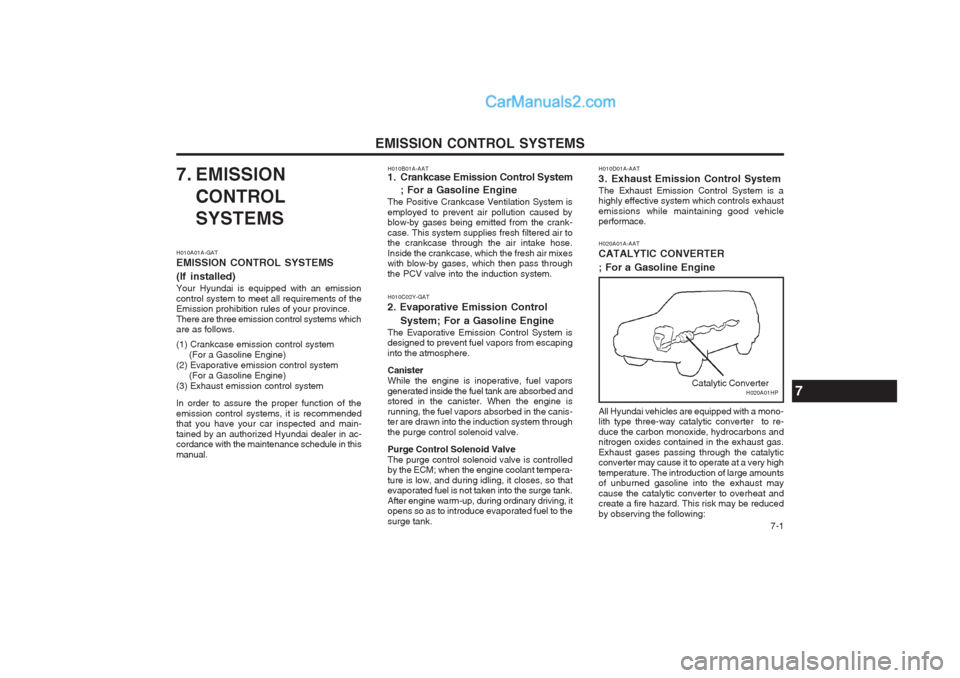
EMISSION CONTROL SYSTEMS 7-1
7. EMISSION
CONTROL SYSTEMS
H010A01A-GAT EMISSION CONTROL SYSTEMS (If installed) Your Hyundai is equipped with an emission control system to meet all requirements of the Emission prohibition rules of your province. There are three emission control systems which are as follows. (1) Crankcase emission control system (For a Gasoline Engine)
(2) Evaporative emission control system (For a Gasoline Engine)
(3) Exhaust emission control system In order to assure the proper function of the emission control systems, it is recommended that you have your car inspected and main- tained by an authorized Hyundai dealer in ac- cordance with the maintenance schedule in this manual. H010C02Y-GAT 2. Evaporative Emission Control
System; For a Gasoline Engine
The Evaporative Emission Control System is
designed to prevent fuel vapors from escaping into the atmosphere. Canister While the engine is inoperative, fuel vapors
generated inside the fuel tank are absorbed and stored in the canister. When the engine is
running, the fuel vapors absorbed in the canis- ter are drawn into the induction system through the purge control solenoid valve. Purge Control Solenoid Valve The purge control solenoid valve is controlled
by the ECM; when the engine coolant tempera- ture is low, and during idling, it closes, so that evaporated fuel is not taken into the surge tank.
After engine warm-up, during ordinary driving, it opens so as to introduce evaporated fuel to the surge tank. H020A01A-AAT CATALYTIC CONVERTER ; For a Gasoline Engine
H020A01HP
Catalytic Converter
All Hyundai vehicles are equipped with a mono- lith type three-way catalytic converter to re- duce the carbon monoxide, hydrocarbons and nitrogen oxides contained in the exhaust gas. Exhaust gases passing through the catalytic converter may cause it to operate at a very high temperature. The introduction of large amounts of unburned gasoline into the exhaust may cause the catalytic converter to overheat and create a fire hazard. This risk may be reduced by observing the following:
H010B01A-AAT
1. Crankcase Emission Control System
; For a Gasoline Engine
The Positive Crankcase Ventilation System is employed to prevent air pollution caused by blow-by gases being emitted from the crank- case. This system supplies fresh filtered air to the crankcase through the air intake hose. Inside the crankcase, which the fresh air mixes with blow-by gases, which then pass through the PCV valve into the induction system.7
H010D01A-AAT
3. Exhaust Emission Control SystemThe Exhaust Emission Control System is a highly effective system which controls exhaust emissions while maintaining good vehicle performace.
Page 174 of 349
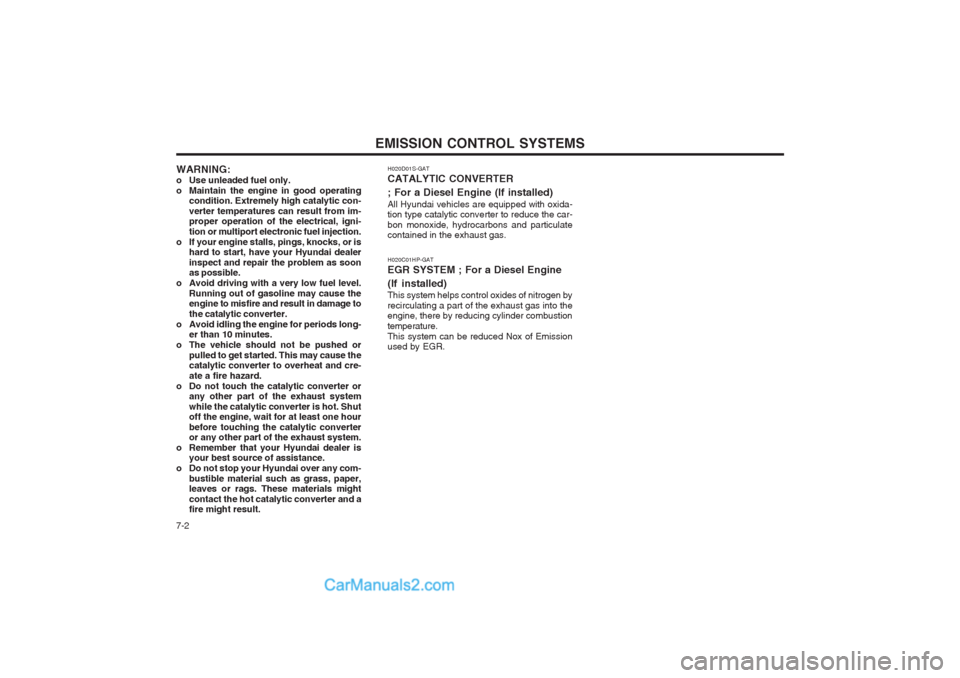
7-2EMISSION CONTROL SYSTEMS
WARNING:
o Use unleaded fuel only.
o Maintain the engine in good operating condition. Extremely high catalytic con-verter temperatures can result from im- proper operation of the electrical, igni- tion or multiport electronic fuel injection.
o If your engine stalls, pings, knocks, or is hard to start, have your Hyundai dealerinspect and repair the problem as soon as possible.
o Avoid driving with a very low fuel level. Running out of gasoline may cause theengine to misfire and result in damage to the catalytic converter.
o Avoid idling the engine for periods long- er than 10 minutes.
o The vehicle should not be pushed or pulled to get started. This may cause the catalytic converter to overheat and cre- ate a fire hazard.
o Do not touch the catalytic converter or any other part of the exhaust systemwhile the catalytic converter is hot. Shut off the engine, wait for at least one hour before touching the catalytic converter or any other part of the exhaust system.
o Remember that your Hyundai dealer is your best source of assistance.
o Do not stop your Hyundai over any com- bustible material such as grass, paper,leaves or rags. These materials might contact the hot catalytic converter and a fire might result. H020C01HP-GAT EGR SYSTEM ; For a Diesel Engine (If installed) This system helps control oxides of nitrogen by recirculating a part of the exhaust gas into the engine, there by reducing cylinder combustion temperature.This system can be reduced Nox of Emission used by EGR.
H020D01S-GAT CATALYTIC CONVERTER ; For a Diesel Engine (If installed) All Hyundai vehicles are equipped with oxida- tion type catalytic converter to reduce the car- bon monoxide, hydrocarbons and particulate contained in the exhaust gas.
Page 175 of 349
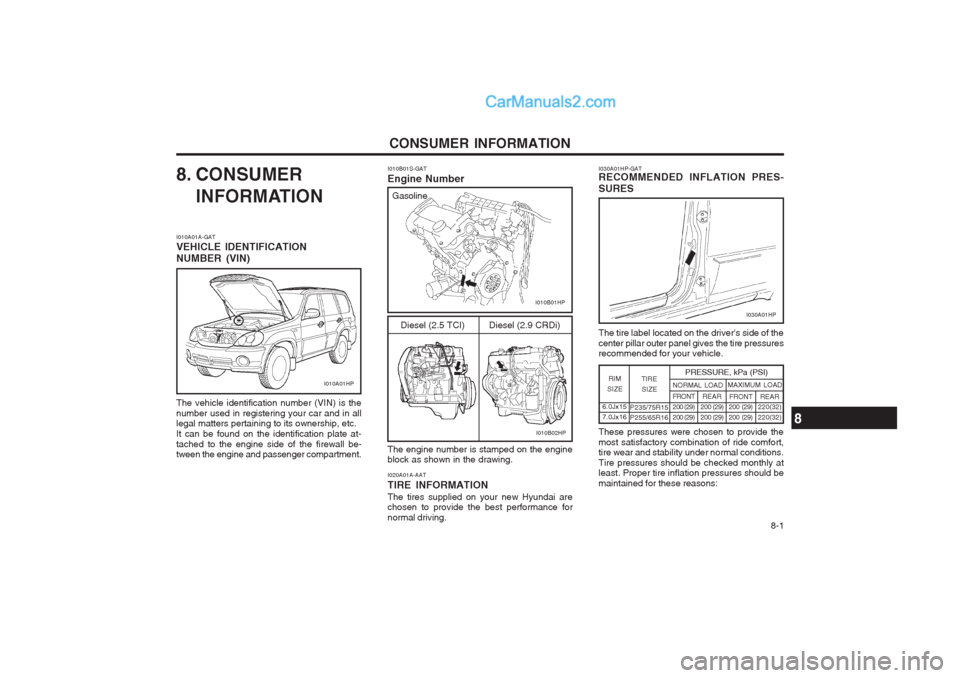
CONSUMER INFORMATION 8-1
8. CONSUMER
INFORMATION
I010A01A-GAT VEHICLE IDENTIFICATION NUMBER (VIN) The vehicle identification number (VIN) is the number used in registering your car and in all legal matters pertaining to its ownership, etc. It can be found on the identification plate at-tached to the engine side of the firewall be- tween the engine and passenger compartment. I020A01A-AAT TIRE INFORMATIONThe tires supplied on your new Hyundai are chosen to provide the best performance for normal driving.
I010A01HP I030A01HP-GAT RECOMMENDED INFLATION PRES- SURES
The tire label located on the driver's side of the center pillar outer panel gives the tire pressures recommended for your vehicle.
I030A01HP
I010B01S-GAT Engine Number The engine number is stamped on the engine block as shown in the drawing.
I010B02HP
8
I010B01HP
Diesel (2.9 CRDi)
Diesel (2.5 TCI)
Gasoline
6.0Jx15 7.0Jx16
TIRE
SIZE
RIM
SIZE PRESSURE, kPa (PSI)
P235/75R15 P255/65R16 REAR
200 (29) 200 (29) FRONT
200 (29)200 (29)
NORMAL LOAD
MAXIMUM LOAD
REAR
220(32)220(32)
FRONT200 (29)200 (29)
These pressures were chosen to provide the most satisfactory combination of ride comfort, tire wear and stability under normal conditions. Tire pressures should be checked monthly at least. Proper tire inflation pressures should be maintained for these reasons:
Page 176 of 349
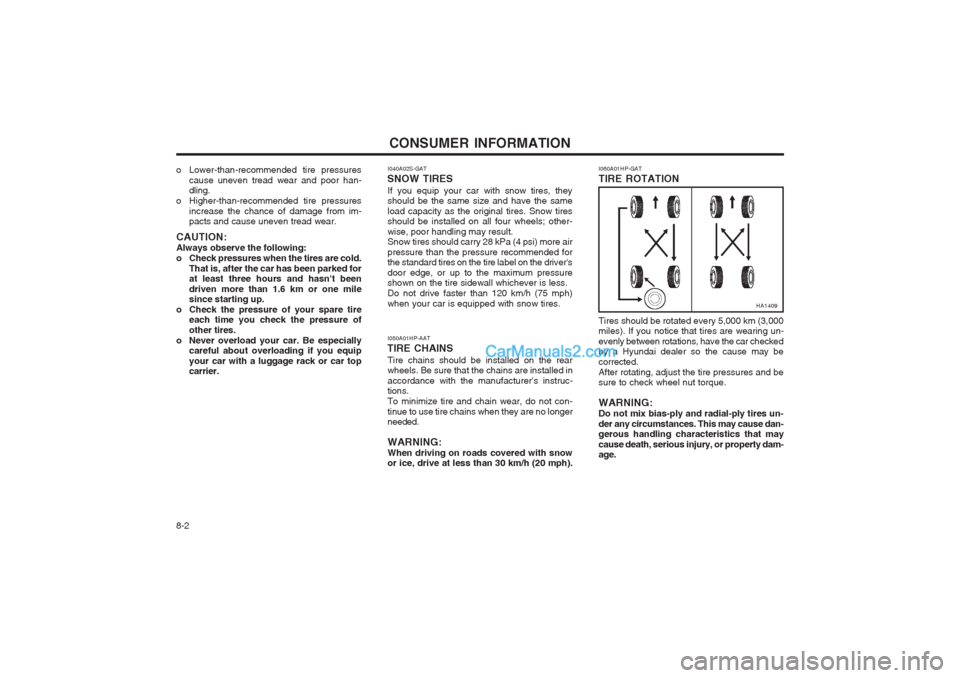
CONSUMER INFORMATION
8-2 I060A01HP-GAT TIRE ROTATION
I040A02S-GAT
SNOW TIRES If you equip your car with snow tires, they should be the same size and have the same load capacity as the original tires. Snow tires should be installed on all four wheels; other- wise, poor handling may result. Snow tires should carry 28 kPa (4 psi) more air pressure than the pressure recommended for the standard tires on the tire label on the driver's door edge, or up to the maximum pressure shown on the tire sidewall whichever is less. Do not drive faster than 120 km/h (75 mph)when your car is equipped with snow tires. I050A01HP-AAT
TIRE CHAINS Tire chains should be installed on the rear wheels. Be sure that the chains are installed in accordance with the manufacturer's instruc- tions. To minimize tire and chain wear, do not con-tinue to use tire chains when they are no longer needed. WARNING: When driving on roads covered with snow or ice, drive at less than 30 km/h (20 mph). Tires should be rotated every 5,000 km (3,000
miles). If you notice that tires are wearing un- evenly between rotations, have the car checked by a Hyundai dealer so the cause may be corrected.After rotating, adjust the tire pressures and be sure to check wheel nut torque. WARNING: Do not mix bias-ply and radial-ply tires un-
der any circumstances. This may cause dan- gerous handling characteristics that may
cause death, serious injury, or property dam- age.
o Lower-than-recommended tire pressures
cause uneven tread wear and poor han-dling.
o Higher-than-recommended tire pressures
increase the chance of damage from im-pacts and cause uneven tread wear.
CAUTION: Always observe the following:
o Check pressures when the tires are cold. That is, after the car has been parked for at least three hours and hasn't been driven more than 1.6 km or one mile since starting up.
o Check the pressure of your spare tire each time you check the pressure of other tires.
o Never overload your car. Be especially careful about overloading if you equipyour car with a luggage rack or car top carrier.
HA1409
Page 177 of 349
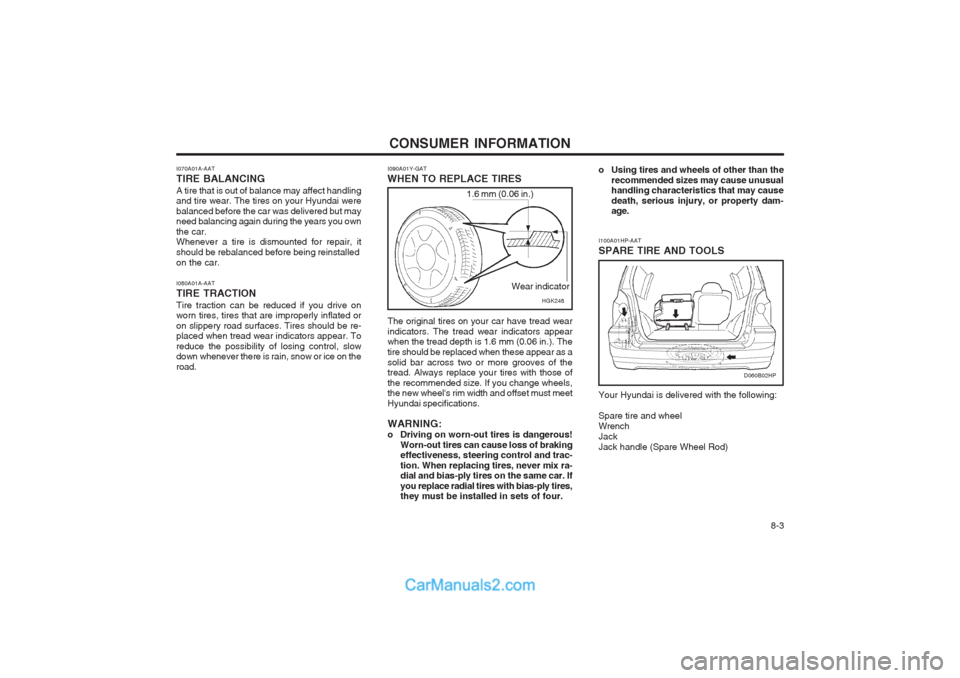
CONSUMER INFORMATION 8-3
I070A01A-AAT TIRE BALANCINGA tire that is out of balance may affect handling and tire wear. The tires on your Hyundai were balanced before the car was delivered but may need balancing again during the years you own the car. Whenever a tire is dismounted for repair, it should be rebalanced before being reinstalledon the car.
I100A01HP-AAT SPARE TIRE AND TOOLS Your Hyundai is delivered with the following: Spare tire and wheel WrenchJackJack handle (Spare Wheel Rod)
I080A01A-AAT TIRE TRACTIONTire traction can be reduced if you drive on worn tires, tires that are improperly inflated or on slippery road surfaces. Tires should be re- placed when tread wear indicators appear. To reduce the possibility of losing control, slow down whenever there is rain, snow or ice on the road. I090A01Y-GAT
WHEN TO REPLACE TIRES
The original tires on your car have tread wearindicators. The tread wear indicators appear when the tread depth is 1.6 mm (0.06 in.). The tire should be replaced when these appear as asolid bar across two or more grooves of the tread. Always replace your tires with those of the recommended size. If you change wheels, the new wheel's rim width and offset must meet Hyundai specifications. WARNING:
o Driving on worn-out tires is dangerous! Worn-out tires can cause loss of braking effectiveness, steering control and trac- tion. When replacing tires, never mix ra- dial and bias-ply tires on the same car. If
you replace radial tires with bias-ply tires, they must be installed in sets of four.
D060B02HP
Wear indicator
1.6 mm (0.06 in.)
HGK248o Using tires and wheels of other than the
recommended sizes may cause unusual handling characteristics that may cause death, serious injury, or property dam- age.
Page 178 of 349
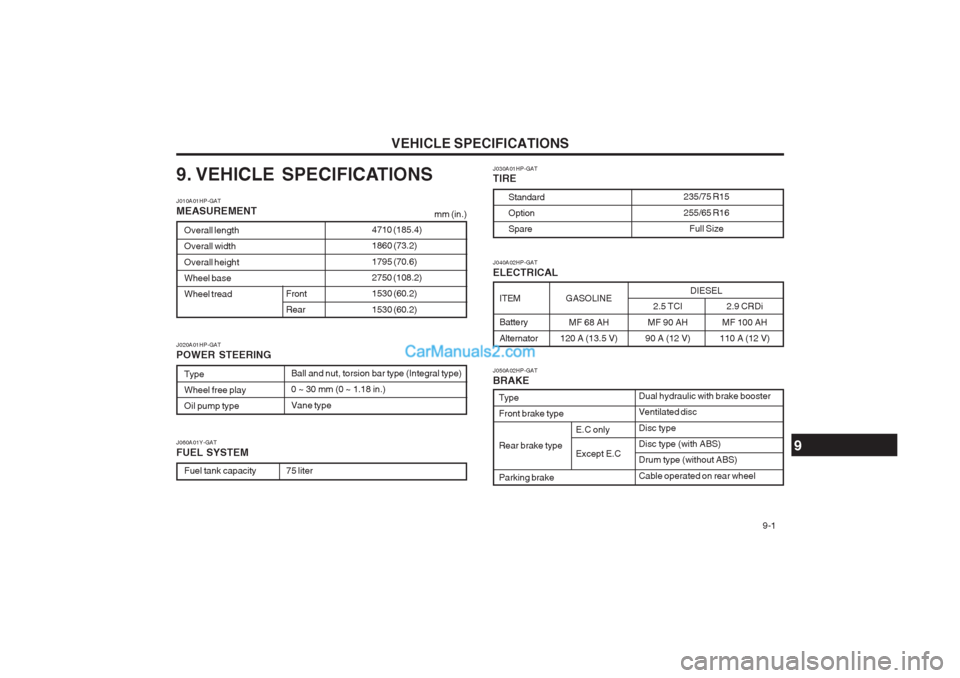
VEHICLE SPECIFICATIONS 9-1
GASOLINE
MF 68 AH
120 A (13.5 V)
9. VEHICLE SPECIFICATIONS J010A01HP-GAT MEASUREMENT
Overall length Overall width Overall height Wheel baseWheel tread
Front Rear
Type Wheel free playOil pump type
Ball and nut, torsion bar type (Integral type)0 ~ 30 mm (0 ~ 1.18 in.) Vane type
J020A01HP-GAT POWER STEERING J030A01HP-GAT TIRE
Standard OptionSpare235/75 R15 255/65 R16
Full Size
J050A02HP-GAT BRAKE Dual hydraulic with brake booster Ventilated disc Disc type Disc type (with ABS)Drum type (without ABS) Cable operated on rear wheel
Type Front brake type Rear brake typeParking brake
J060A01Y-GAT FUEL SYSTEM
Fuel tank capacity75 liter mm (in.)
4710 (185.4) 1860 (73.2) 1795 (70.6) 2750 (108.2)1530 (60.2) 1530 (60.2)
ITEM Battery Alternator
J040A02HP-GAT ELECTRICAL
2.5 TCI
MF 90 AH
90 A (12 V)
9
2.9 CRDi
MF 100 AH
110 A (12 V)
DIESEL
E.C only Except E.C
Page 179 of 349
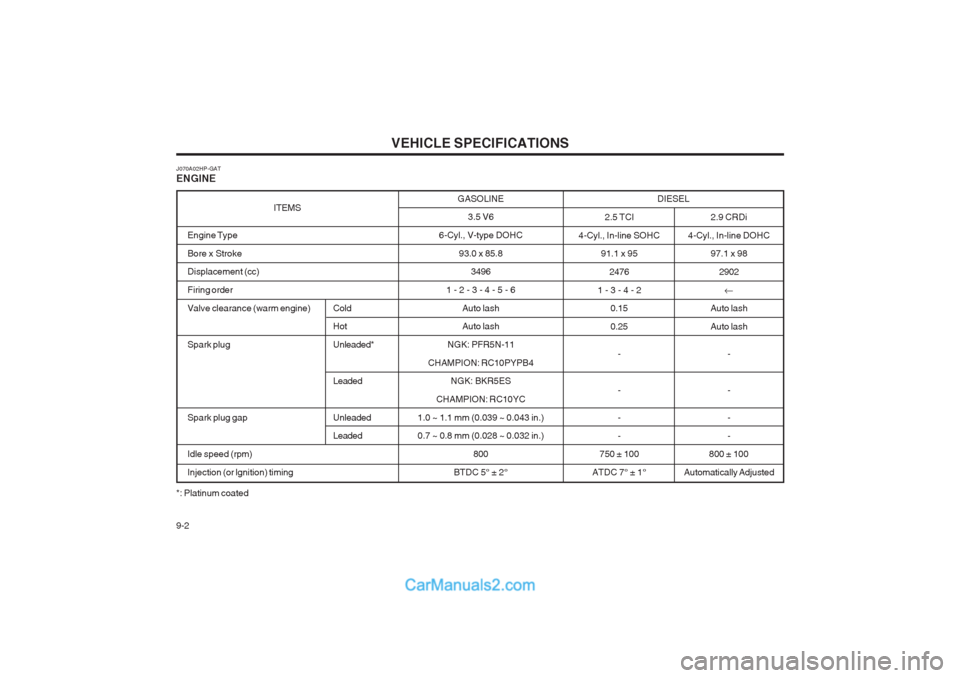
VEHICLE SPECIFICATIONS
9-2 ITEMS
Engine Type Bore x Stroke Displacement (cc) Firing orderValve clearance (warm engine) Cold Hot
Spark plug Unleaded* Leaded
Spark plug gap Unleaded Leaded
Idle speed (rpm) Injection (or lgnition) timing 2.5 TCI
4-Cyl., In-line SOHC 91.1 x 95
2476
1 - 3 - 4 - 2 0.150.25
- - - -
750 ± 100
ATDC 7° ± 1°
J070A02HP-GAT ENGINE
GASOLINE
3.5 V6
6-Cyl., V-type DOHC 93.0 x 85.83496
1 - 2 - 3 - 4 - 5 - 6 Auto lash Auto lash
NGK: PFR5N-11
CHAMPION: RC10PYPB4 NGK: BKR5ES
CHAMPION: RC10YC
1.0 ~ 1.1 mm (0.039 ~ 0.043 in.)0.7 ~ 0.8 mm (0.028 ~ 0.032 in.)
800
BTDC 5° ± 2°
2.9 CRDi
4-Cyl., In-line DOHC 97.1 x 98
2902
�
Auto lash Auto lash
- - - -
800 ± 100
Automatically Adjusted
DIESEL
*: Platinum coated
Page 180 of 349
![Hyundai Terracan 2003 Owners Manual VEHICLE SPECIFICATIONS 9-3
Oil & Grease Standard
E.C API SG, SAE 20W-40, 20W-50 [ABOVE -10°C (14°F)]
only SG/CD, SAE 15W-40, 15W-50 [ABOVE -15°C (5°F)]
SH or SH/CD SAE 10W-30 [-25°C ~ 40°C(-13 Hyundai Terracan 2003 Owners Manual VEHICLE SPECIFICATIONS 9-3
Oil & Grease Standard
E.C API SG, SAE 20W-40, 20W-50 [ABOVE -10°C (14°F)]
only SG/CD, SAE 15W-40, 15W-50 [ABOVE -15°C (5°F)]
SH or SH/CD SAE 10W-30 [-25°C ~ 40°C(-13](/img/35/19680/w960_19680-179.png)
VEHICLE SPECIFICATIONS 9-3
Oil & Grease Standard
E.C API SG, SAE 20W-40, 20W-50 [ABOVE -10°C (14°F)]
only SG/CD, SAE 15W-40, 15W-50 [ABOVE -15°C (5°F)]
SH or SH/CD SAE 10W-30 [-25°C ~ 40°C(-13°F ~ 104°F)] SAE 10W-40, 10W-50 [ABOVE -25°C(-13°F)]
Except API SE SAE 5W-20 [BELOW -10°C(14°F)] *1, *2
E.C or ABOVE SAE 5W-30 [BELOW 10°C(50°F)] *1 SAE 5W-40 [BELOW 20°C(68°F)] *1
API CF-4 or ABOVE, SAE #30 [ABOVE 0°C(32°F)]
ACEA B2 or B3 SAE 20W-40 [ABOVE -10°C(14°F)] SAE 15W-40 [ABOVE -15°C(5°F)]SAE 10W-30 [-20°C ~ 40°C (-4°F ~ 104°F)]SAE 5W-30 [-25°C ~10°C (-13°F ~ 50°F)]SAE 0W-30 [BELOW 10°C(50°F)] *1
API CF-4 or ABOVE, SAE 40 [0°C ~ 40°C(32°F ~ 104°F)]
ACEA B4 or ABOVE SAE 30 [0°C ~ 30°C(32°F ~ 86°F)] SAE 20W-20 [-10°C ~ 20°C(14°F ~ 68°F)]SAE 10W-30 [-20°C ~ 30°C(-4°F ~ 86°F)]SAE 5W-30 [-25°C ~ 30°C(-13°F ~ 86°F)]
*1. Restricted by driving condition and dealing area*2. Not recommended for sustained high speed vehicle operationNormal driving conditionSevere driving condition
J080A05HP-GAT LUBRICATION CHART
Q’ty (liter)
Drain and refill (With oil filter):4.3 Drain and refill (With oil filter) : 6.5 Drain and refill (With oil filter) : 7.1 MAX. 1L /1500 Km MAX. 1L /1000 Km
Item
Engine oil (Gasoline) Engine oil (Diesel (2.5 TCI)) Engine oil (Diesel (2.9 CRDi)) Engine oil consumption